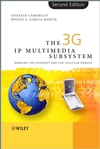
Wireless VoIP is a hot topic at the moment and the name is used for quite a number of different technologies. In this mini series on my blog I’ve already taken a look at UMA in part one and SIP in part two. This entry takes a closer look at the IMS, the IP Multimedia Subsystem.
In very generic terms, SIP as described in part two is the core of the IMS. In addition, the IMS standardizes a number of additional functionalities:
- SIP is the abbreviation for Session Initiation Protocol. As it is just a session (e.g. voice call) initiation protocol, it does not contain any mechanisms to ensure Quality of Service or a certain bandwidth of the connection. While fixed networks usually have enough bandwidth available to ensure the quality of a call, things are different in mobile networks. Here, bandwidth to and from a subscriber is limited. In addition, the total bandwidth of a base station that has to be shared by all users of the base station is also limited and much scarcer than in the fixed line world. To ensure that a voice or video call established with an IMS capable device is maintained with a good quality of service (e.g. jitter, latency, etc.) and that a sufficient amount of bandwidth is ensured for the call while it is established, the IMS contains mechanisms to communicate with the radio network to ensure enough bandwidth is reserved during the call.
- IMS standardizes authentication and encryption of SIP commands and responses in the network.
- IMS standardizes how media gateways are controlled to enable SIP clients to establish connections with legacy circuit switched fixed line and wireless clients.
- IMS standardizes the access to the Home Subscriber Server (HSS, aka HLR) in the GSM/UMTS/CDMA network.
- IMS standardizes what kind of information is put on the SIM card of the subscriber and in which way.
- IMS standardizes the codecs used for different services (e.g. voice codecs, video codecs)
- And very important: IMS standardizes a service framework and a protocol between the IMS core and application servers that allows third parties to create new services based on IMS and SIP commands. Such services are for example instant messaging, presence, voice mail, video mail, location based services, short dialing numbers, private dialing plans, music and video streaming, push to talk, etc.
- And last but not least: IMS standardizes how to get billing information because after all, operators want to make money with it.
By standardizing all of these aspects it is ensured that an operator can buy different parts of the overall IMS solution from different vendors. In turn, the architecture also ensures that application developers can design new applications for a standard platform and can then sell their products without customization to many different network operators. Furthermore, this approach ensures that IMS systems of different operators can interoperate with each other. This is a fundamental requirement to enable calls between different national and international operators without using media gateways.
Want to know more? Here’s a good book on the topic that I can recommend as it was great fun reading it: "The 3G IP Multimedia Subsystem" by Gonzalo Camarillo and Miguel A. Garcia-Martin. It’s in it’s second edition already after only a year so I guess I am not the only one who likes it.